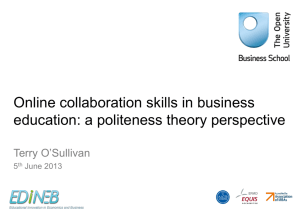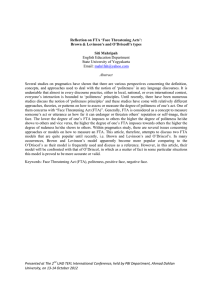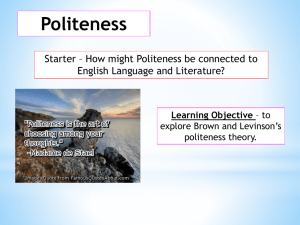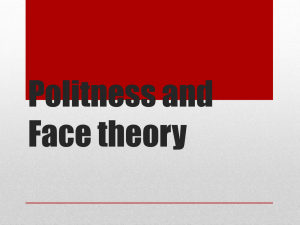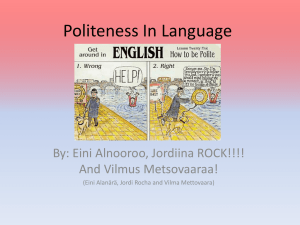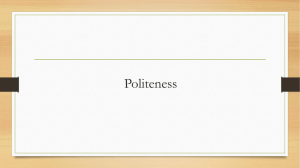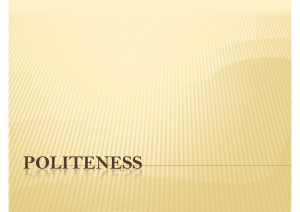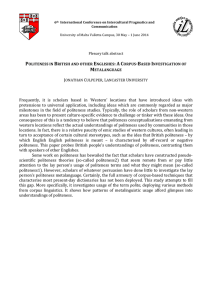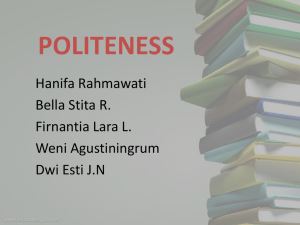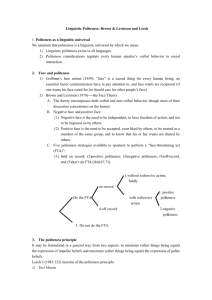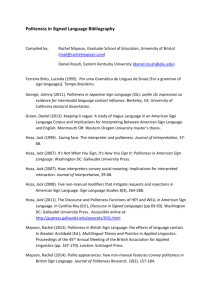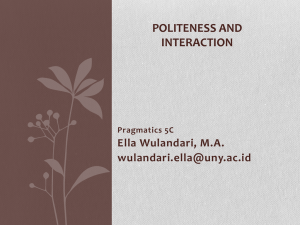face_and_asian_culture
advertisement
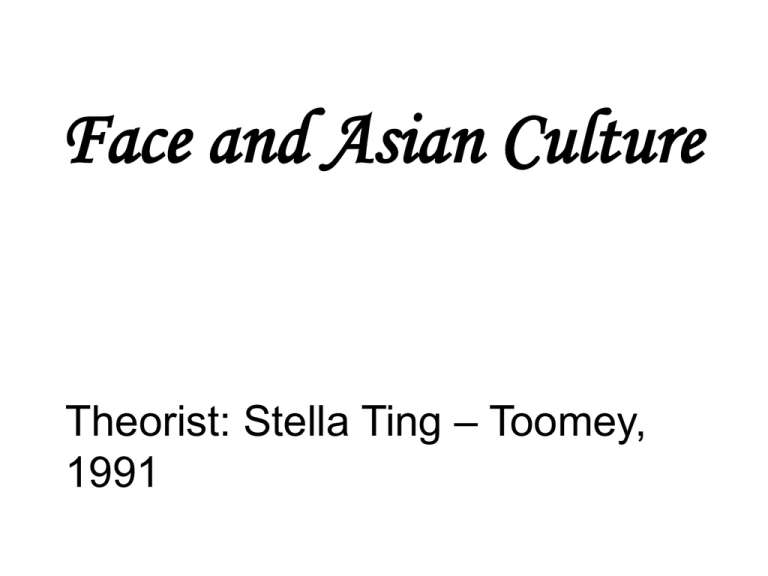
Face and Asian Culture Theorist: Stella Ting – Toomey, 1991 Although popular Western wisdom regards face as an Asian preoccupation, many relational researchers consider it a universal concern. It is an extension of self-concept. It is a vulnerable identity-based resource. For example, when we blush, it’s a sign that we feel, awkward, embarrassed, or proud– all face-related issues (TingToomey, 1991). DEFINITIONS of FACE • Stella Ting-Toomey: the projected image of one’s self in a relational situation • Penelope Brown & Steven Levinson: the public self-image that every member of society wants to claim for himself/herself • L. Yutang: a psychological image that can be granted, lost, and fought for, and presented as a gift. The term includes patrician concern for dignity, honor, and status; can also include arrogant “trash talk” (in your face) - As a proponent of face-negotiation theory, Ting-Toomey reminds us that there are many places in the world where face concerns focus on the other person. Even in the midst of conflict, people in collectivistic cultures pay as much or more attention to maintaining the other party’s face as they do to preserving their own. FACE WORK STRATEGIES 1. Face-Restoration: the strategy used to stake out a unique place in life, preserve autonomy, and defend against loss of personal freedom. It is the typical strategy across individualistic cultures. 2. Face Giving: the strategy used to defend and support another person’s need for inclusion. It means taking care not to embarrass or humiliate the other in public. It is the characteristic strategy for collectivist cultures Face-negotiation Theory suggests a two-step causal chain with face maintenance as the explanatory link between culture and style of conflict resolution: Type of Culture -> Type of Face Maintenance -> Type of Conflict Management FIVE TYPES of CONFLICT MANAGEMENT in FACE-NEGOTIATION THEORY 1. Avoiding (withdrawing): “I would avoid open discussion of my differences with the group member.” 2. Obliging (giving in): “I would give in to the group member’s wishes.” 3. Compromising (negotiating): “I would use give and take so that a compromise could be made.” 4. Dominating (competing): “I would be firm in pursuing my side of the issue.” 5. Integrating (problem-solving): “I would exchange accurate information with the group member to solve the problem together.” Each of the five styles vary according to their mix of concern for self-face and other-face. ADDITIONAL CONFLICTMANAGEMENT STYLES 1. Emotional Expression: “Whatever my gut and heart tell me, I would let this feeling show.” 2. Passive Aggression: “Without actually accusing anyone of being lazy, I’d try to make him/her feel guilty.” 3. Third-Party Help: “I would enlist the professor to help us in solving the conflict.” Collectivists adopting these styles focus on relational-level collaboration and concession, whereas individualists concentrate on solving the task problem in a way that brings closure (Ting-Toomey & Kurogi, 1998). Collectivists prefer seeking help from a familiar third-party while individualists want advice from an impartial person they may not know. Third-party mediators are usually people who are highly-regarded by both parties in a dispute. POLITENESS MODEL (Brown and Levinson) -Politeness defined: the expression of the speaker’s intention to mitigate face threats carried by certain face-threatening acts (FTAs) toward another. - Politeness consists of efforts to save face for another -Mitigate means to make less severe. -FTAs are someone else’s behavior going against what you want to put forward. Brown and Levinson believe that politeness is universal, although different cultures have different levels of required politeness and different ways of being polite. Politeness is universal is because all people have the need to be appreciated & protected, which Brown and Levinson call face needs. TYPES of FACE / FACE-NEEDS Positive Face: the desire to be appreciated and approved, be liked and honored, and positive politeness is designed to meet these desires. Example: showing concern, complimenting, using respectful forms of address. Negative Face: the desire to be free from imposition or intrusion, and negative politeness protects the other person when negative face needs are threatened. Example: acknowledging the imposition upon a request. FIVE APPROACHES when USING FTAs 1. Deliver the FTA without polite action (blatant, no attempt to acknowledge what the hearer’s face wants) 2. Deliver the FTA with some form of positive politeness (the threat to face is relatively low) 3. Deliver the FTA with some form of negative politeness (the threat to face is relatively high) 4. Deliver the FTA indirectly (do it off-the-record, the threat to face is very high) 5. Don’t deliver the FTA at all (the threat to face is extremely high) Positive face is when people want that their goals, possessions, and achievements are ratified, understood, approved of, liked, or admired. Negative face is when we don’t want others to take advantage of us by threatening our face. INDIGENOUS MODEL (Jocano, 1992) - Based on native or traditional values and practices - Embedded in the deeper strata of our individual and collective subconscious - Non-legal and customary - Serves as framework for local ways of thinking, believing, feeling, and acting outside of the bureaucracy and corporate organizations’ formal environment - Has the moral and ethical support of community practices CULTURE CLASH IN FILIPINO FORMAL and NON-FORMAL ORGANIZATIONS I. Institutional Demands A. Non-Formal Community • Kinship Loyalty • Familism • Friends • Prompt Service • Elderly Concern • Strictness B. Formal Bureaucracy • • • • • According to Rules Through Channels Individualism Frankness According to Merit Cultural Demands Non-Formal Community Gift Giving Social Obligation Facilitating Things Bahala Sangguni Asa Awa Utang na Loob Cultural Interpretation Formal Bureaucracy - Nepotism - Favoritism - Cronies - Personalism - Autocratism - Authoritarianism Formal Community - Red Tape Bureaucratic Unconcerned Rudeness No Sympathy Institutional Interpretation Formal Bureaucracy -Bribery -Unreasonable Demands -Influence-Peddling -Lack of Initiative -Fatalism -Lack of Leadership -Dependency -Petty Sentimentalism -Corruption The value orientations based on these models have given us “splitlevel” orientations which have undermined our confidence in our system and blurred our vision for development If a Filipino strictly follows the bureaucracy’s legal rules, he incurs the community’s ire for being too legalistic, formal and bureaucratic If he follows the community’s moral expectations, he is condemned by the bureaucracy for violating nepotism and corruption laws. If he acts objectively in managing people at work, he is criticized for being too Westernized. If he is frank and open with his criticism, he is accused of being too rude and without manners; if he is silent, he is criticized for not being frank and intellectually dishonest. If he is too professional in his dealings, he is criticized for being too individualistic and lacking in human compassion; if he is soft and understanding, he lacks leadership and managerial capabilities Our communication technique is euphemism, persuasion, not ordering, is considered the appropriate way for getting group consensus and action. Argumentation and debate are avoided because the style often hurts Filipinos’ sensitivities. How To Reconcile Modern And Traditional Values Go back to the basics of our culture and rediscover its positive and inner strengths. Borrow the Western system’s best elements and graph these to our native knowledge to make modernization possible without breakdowns. Preserve our national heritage, define national values such as ugnayan, pananagutan, balikatan, bayanihan, and galang.
